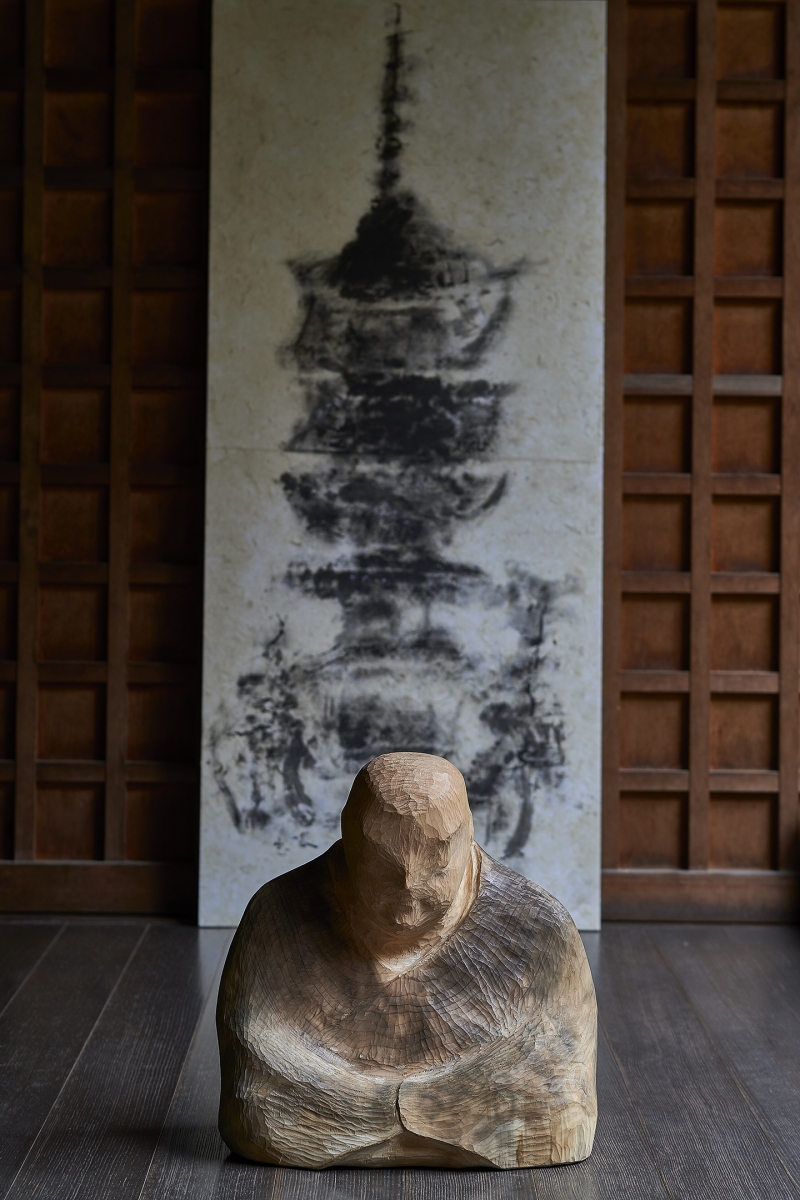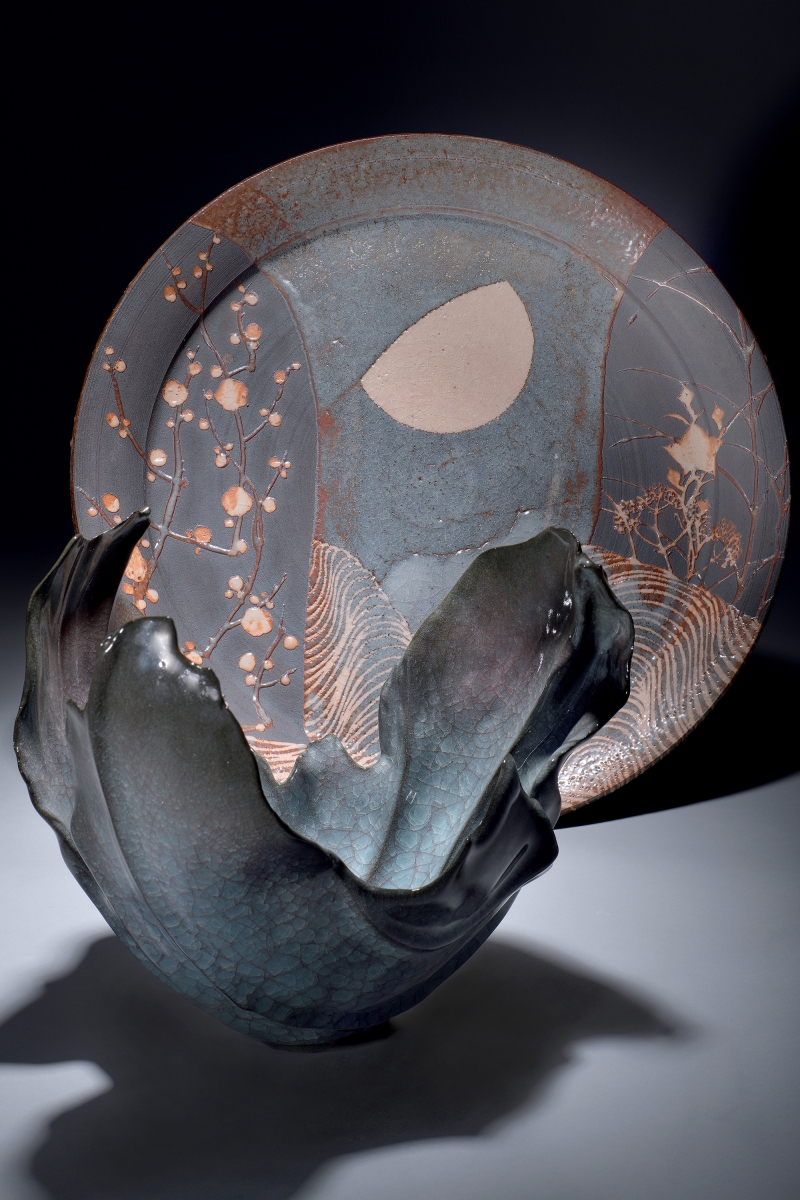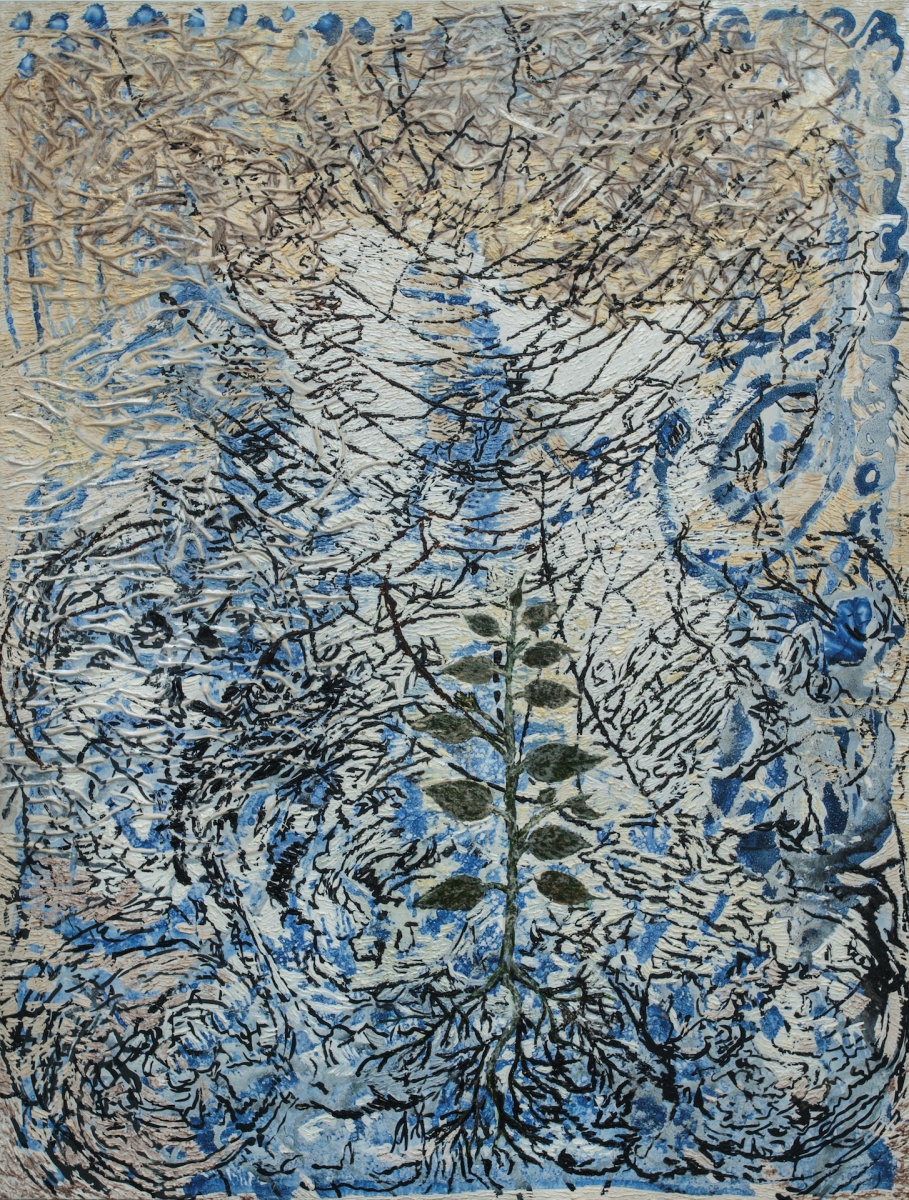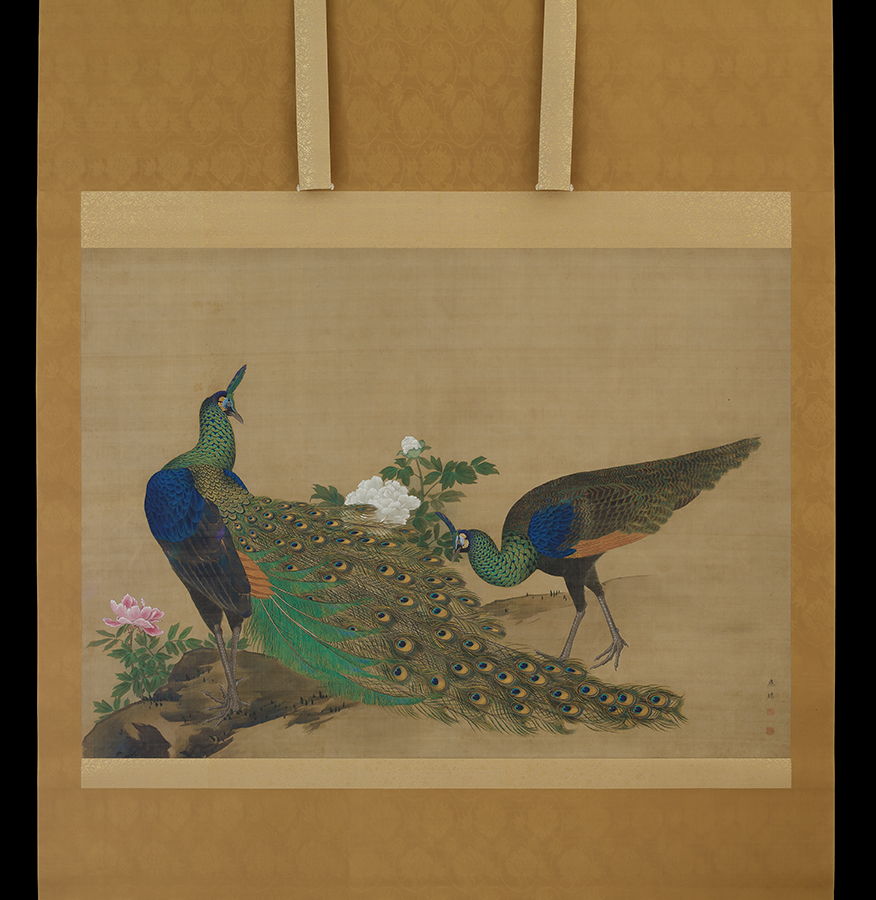
To coincide with September Asia Week, several of our regular dealer participants are holding exhibitions showcasing traditional and contemporary examples of Asian painting, sculpture, ceramics, and more. Most of our New York based dealers will be open by appointment only for in person exhibition viewings. Here's our guide to the exhibitions on view.

HIGASHIDA Shigemasa 東田茂正一(1955- )
Oribe Ceramic Box No. 2-5 織部陶箱, 2020
H7” x W13.3” x D6.7”, 18 x 34 x 17cm
Stoneware
With Signed Wood Box
Dai Ichi Arts, Ltd. is presenting “The Call of Nature – Oribe Ceramic by Higashida Shigemasa.” Higashida Shigemasa 東田茂正 pursues the Oribe glaze tradition with a unique and dramatic flair. Turning to ceramics after a brief but successful career at a major stock firm, Higashida's work is characterized by a lush and vibrant glaze that pools and flows over invitingly textured clay. Here, brilliant turquoise blue lakes of glaze occupy the valleys and crevices of the lush green surface. The dynamic shape of the ox recalls mountainous landscapes with their undulating crests and valleys. This rough topography is countered by the serene stillness of the pooled blue glaze which offers a restful point of contemplation for the eye. The gallery is open by appointment only, and the exhibition is on view at 18 East 64th Street, #1F, from September 10- 26. For more information please contact Beatrice Chang at +1 917 435 9473 or email [email protected].

Torii Kotondo (1900-1975)
Combing the Hair (Kamisuki), 1929
Japanese color woodblock print
46.8 x 29.6 cm
1st Edition
Egenolf Gallery Japanese Prints presents “Beauty & Style: Early 20th Century Japanese Prints” in our September online viewing room. Featured above is Torii Kotondo's “Combing the Hair (Kamisuki)” depicting a nude beauty applying a comb to her long tresses. The rounded contours of her body are given volume with soft pink and her outlines have been blindprinted with no pigment, in contrast with the baren-produced (baren-sujizuri) texture of the background. Due to the design's rarity and popularity there was a contemporary reprint created in the 2000s by a Japanese publisher, but it is considered to be an homage to this work.
Sooyeon Hong
Equilibrium_acrobat #13, 2017
Acrylic on linen
39 3/8 x 31 1/2 in. (100 x 80 cm)
HK Art & Antiques presents Time of Peace: Works by Women Artists, with the focus on three noted female contemporary Korean painters: Su Kwak, Ouhi Cha and Sooyeon Hong. Kwak and Cha have spent many years outside Korea and are currently based in the US and Germany respectively. All three have had exhibitions both in Korea and the US. Throughout the exhibition from September 17 – October 7, the gallery is open by appointment at 49 East 78th Street, #4A. Highlights can be seen in our viewing room.

Sho Kishino
Seated, B21420, 2020
H14 1/4 x W13 x D8 in. (H36 x W33 x D20 cm.)
Cypress (hinoki)
Ippodo Gallery is showing “Samsara: Sculptures by Sho Kishino.” This delicately carved sculpture, made from Japanese Cypress (hinoki), shows a seated figure seemingly weighted down in deep thought. Faint markings and shadows create the impression of furrowed brows and closed lips, and the figure's motionless hands are hidden within their robe. The wood and square composition create a sense of solidity, strength, and the physicality of meditation. The works are on view from September 10 – October 8 by appointment at their gallery at 32 East 67th Street, 3rd Floor, with highlights featured in Asia Week New York's September online exhibition.
![]()
KATSUKAWA SHUNSHO (1726 – 1792). Ichikawa Yaozo II as Hachioaru Aratora and Segawa Kikunojo III as Aigo no Waka. Color woodblock print: hosoban, 12 7/8 x 6 in. (32.7 x 15.2 cm.); 1774. Signed: Shunsho ga.
Published: Narazaki, Muneshige, et al. 1976. Shunsho. Vol. 3, Ukiyo-e taikei (Encyclopedia of Ukiyo-e). Tokyo: Shueisha, pl. 26.
Sebastian Izzard LLC Asian Art is putting “A Selection of Fine Japanese Paintings, Prints, and Ceramics,” on view in his gallery at 17 East 76th Street, 3rd Floor from September 14 – 25, in which fine examples in each of these media can be seen by appointment. Several highlights are included in Asia Week New York's September online viewing room until October 4th, 2020. One of these is a woodblock print by Katsukawa Shunshō (1726–1792), a striking depiction of Ichikawa Yaozō II as Hachiōmaru Aratora and Segawa Kikunojō III as Aigo no Waka. Yaozo was one of the most famous Edo actors of his generation, and Kikunojo went on to become one of the most successful onnagata (female role players) of the later eighteenth century. Among the ceramics, a dish with chrysanthemum design of the Edo period, Empō/Jōkyō eras (1673−87) of Hizen ware, Nabeshima type: porcelain with underglaze blue and colored enamel decoration, dates from the earliest period of porcelain manufacture at the Ōkawachi kilns, patronized exclusively by the Nabeshima family, and the bright hues of the chrysanthemum and the leaves are typical of early Nabeshima wares.

Front: Wakao Kei (b. 1967). Sculptural open blossom-shaped vessel with blue celadon craquelure glazing that flares deep pink from the firing effects. 2019. Glazed stonware. 10 1/4 x 12 7/8 x 11 1/2 in.
Joan B Mirviss LTD presents “Fathers and Sons,” an exhibition exploring the unique nature of lineage and received tradition as illustrated through two sets of father-son ceramic artists: Suzuki Osamu and his son, Tetsu, and Wakao Toshisada and his son, Kei. Suzuki Osamu, a Living National Treasure, is a master of white Shino ware; his son, Tetsu, specializes in green and blue-green copper Oribe glazes. Wakao Toshisada is an Intangible Cultural Heritage of Gifu prefecture. His nezumi Shino functional work is decorated in the aesthetic of the Rinpa tradition. His son, Kei, experiments with bolder sculptural forms that verge on the abstract and are covered in a range of craquelure celadon glazes. The exhibition is on view from September 14 by appointment at the gallery at 39 East 78th Street, 4th Floor. Selected works are included in Asia Week New York's September viewing room.
![]()
An Unusual Kosometsuke Dish with the Eight Immortals. Late Ming Dynasty, early 17th century. Diameter: 11 3/4 in. (29.8 cm.). Height: 2 in. (5.1 cm.)
The selections in “Fantastics & Eccentrics at Kaikodo,” on view in Asia Week New York's September online viewing room reflect the diversity of this establishment’s holdings, which are culturally inclusive and cover media and disciplines across the board. Stucco is not a forgiving material to handle but that did not deter Kaikodo from acquiring a massive and complexly detailed head of a bodhisattva, a rarity in the market today. Further, it is natural that individuals whose lives and studies were shared by China and Japan should be attracted to a ceramic that also provides a link between those cultural giants. The underglaze-blue decorated kosometsuke porcelain dish in the exhibition is a remarkable product of that connection.
![]()
Yoshita Yukio
Large Bowl, 2016
porcelain with enamel and gold in the kinran-de style
10 1/8 x 20 1/4 x 18 1/2 in. (25.7 x 51.4 x 47 cm.)
Onishi Gallery presents “Contemporary Japanese Porcelain,” a unique exhibition celebrating the creative triumph of Eastern ceramic art. Japanese porcelain evokes a rich cultural heritage innovatively adapted to the present-day. Tradition meets innovation, porcelain artists presenting family legacies, meticulous techniques and refined aesthetics in accordance with contemporary creative design. Nine artists are represented, many among them Living National Treasures including, Inoue Manji (b.1929) who attained that status for his hakuji, Japanese white porcelain ware, while Imaizumi Imaemon XIV is known for his Nabeshima porcelain decorated with Rinpa designs. The show runs from September 8 – October 2 on the gallery website and is also open by appointment (521 West 26th St).

Jayashree Chakravarty
Surviving Energy, 2018
Oil, acrylic, cotton, leaf, jute on canvas
66 x 50 in.
Akar Prakar Art Gallery presents a solo exhibition of Jayashree Chakravarty. Jayashree Chakravarty (b. 1956) is one of India's foremost contemporary artists. She studied at the finest art institutions in India, first at Visva Bharati in the sprawling natural environs of Santiniketan, Kolkata, and then at the Faculty of Fine Arts at MS University, Baroda, where she was exposed to an urban sensibility. Inventing her own creative techniques, using organic material and varied kinds of papers, her installations in the form of paper scrolls remain unique in their conceptions and execution. The artist lives and works in Kolkata, India. The solo exhibition is on view in our online viewing room from September 17 – October 4.
![]()
Utagawa Kunisada (Toyokuni III, 1786-1865). Two Beauties with a Maid Carrying Lantern and Shamisen, ca. 1820. oban tate-e triptych. each sheet signed Gototei Kunisada ga, with publisher's seal Mi (Mikawaya Seiemon), the middle and right sheet includes censor's seal kiwame (approved). 15 1/2 x 35 in. (39.37 x 88.9 cm.)
Scholten Japanese Art presents “Composing Beauty,” an exhibition exploring ways in which bijin (lit. 'beautiful person') are presented in ukiyo-e, focusing on the relationship with other 'composed' genres including poetry, music and dance. On view in Asia Week New York's September 2020 online viewing room.
![]()
Altar with ancestor figure, adu nuwu / adu zatua
Nias, wood, 19th to early 20th century
24 in. (46 cm.)
“Art of Southeast Asia,” is a selection of several highlights Thomas Murray Arts is presenting in the Asia Week New York September viewing room. The cultural origins and periods of the pieces are diverse and offer the opportunity to view rare and less often seen examples of Asian tribal art. The most impressive piece is an altar with an ancestor figure carved of wood from Nias, Indonesia, from the 19th/early 20th century. Ancestor altars of this type adorned the interior of the community clan house. A superb Mask depicting Houshang Monpa or Sherdukpen people from Arunachal Pradesh or Bhutan made of wood with pigment, 19th century or earlier would have been worn in the AcheLhamo/Ajilhamu dance drama.
Onkosai, early 20th century. Handled Karamono Flower Bakset. Bamboo and rattan. Taisho era, 1910s-20s, Japan. 22 x 8 x 4 3/4 in. (56 x 20.2 x 12 cm.)
Thomsen Gallery's September exhibition, Japanese Bamboo Art, includes a wide variety of bamboo and rattan flower baskets from 1900 to 1970, as well as contemporary bamboo sculptures. Of particular note is a hexagonal flower basket made of bamboo and rattan, by Sasaki Kogakusai, from the Showa era, 1960s; an earlier circa 1920s-1930s flower basket with a natural bamboo handle by Maeda Chikubosai is also a fine example. Both are part of our online viewing room.

“Peafowl and Peonies”, Maruyama Ozui (1766 – 1829), Edo period, 18-19th century. Ink, color, and gold on silk. Hanging scroll. H113.8 x W158.3 cm.
Koichi Yanagi Oriental Fine Arts presents Kokon Biannual: Fall 2020. The most striking of the works is a hanging scroll in ink, gold and color on silk of Peafowl and Peonies by the Edo period (18th/19th century) artist, Maruyama Ozui (1766-1829). There is only one other known example of this subject by Ōzui, currently in the Sumitomo Collection in Japan. A Shonzui ware, hexagonal dish with three feet from the Jingdezhen kilns, Jiangxi province, China in the Ming dynasty, 17th century of porcelain decorated with underglaze cobalt blue and iron oxide is the only one of this shape in shonzui ware. These are two of the highlights from this show to be included in the Asia Week New York viewing room. The entire exhibition can be seen from September 16-October 11 by appointment at the gallery at 17 East 71st Street, 4th floor.
![]()
Southern Qingbai Lidded Jar with Pinched Handles. Song Dynasty, 960 – 1279 A.D., China. H22.8 cm.
Zetterquist Galleries will show “Chinese and Japanese Ceramics,” during the month of September. The selection in the Asia Week New York viewing room includes a Song dynasty (960 – 1279 A.D) Southern Qingbai lidded jar with pinched handles from China. Both the treatment of the handles and pagoda shaped lid are very rare, implying that the piece may have been made for export to Southeast Asia. A Nanbokucho – Muromachi Period 14th-15th c. A.D. stoneware “heishi” form bottle vase is an example of the very different Japanese taste as its appeal is unaffected by the damage to two thirds of the mouth-rim, most likely in a kiln accident, evidenced by glaze over damaged areas. The gallery at 3 East 66th Street, #2B will be open by appointment only for in person exhibition viewings.
